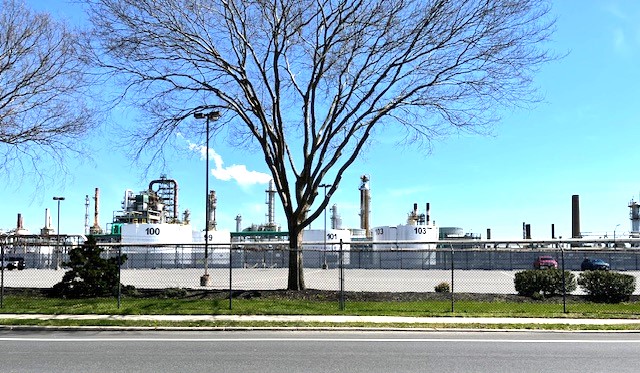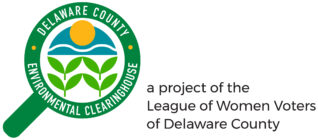Environmentalists Take Monroe Energy to Task at DEP Hearing

The people of the Chester-Marcus Hook industrial corridor are fed up with government permits that allow the polluting industries along the corridor to continue to spew high levels of pollutants into the air.
They are also fed up with the Pennsylvania Department of Environmental Protection’s (PA DEP) own procedures for public hearings that don’t clearly explain the impact of new permits or allow the public to ask questions to better understand them.
That was the message that about 18 speakers delivered to the DEP at a public hearing Jan. 30 at the Marcus Hook Community Center over Monroe Energy’s request for a RACT III permit.
RACT stands for “reasonably available control technology” and the III means it’s an alternative compliance plan and “a significant modification” to the facility’s EPA Title V operating permit under the Clean Air Act, according to the DEP.
What Is Monroe Energy Required to Do?
A very rapid and confusing briefing presented at the beginning of the hearing seemed to indicate the proposed RACT III permit would require Monroe Energy to reduce the amount of nitrogen oxide (NOx) and volatile organic chemicals (VOCS) that combine to produce ozone than is currently allowed.
Nitrogen oxide and VOCs chemically react in the presence of sunlight to form ozone (O3). Ozone can irritate the respiratory system, damaging lung tissue and reducing lung function. This can lead to health problems, such as chest pain, coughing, and asthma attacks.
Whether the change in permitting is major or minor is an open question. The DEP presenter said the EPA has lowered the permitted limit for ozone from .075 parts per millions to .070 PPM – that is, tightened the requirement – but his presentation did not make clear how that applies to Monroe Energy or how significant a change it is.
The Delaware County Environmental Clearinghouse has queried the DEP on those questions but has not yet received a reply. When it does, this article will be updated.
Several speakers said that Monroe Energy has failed to meet current compliance standards for the release of pollutants for 23 of the last 24 quarters (pollution measurements are taken by quarters).
Monroe Energy, which did not present speakers, is arguing that there is no “reasonably available technology” to improve its compliance at three major sources of pollution at its Trainer facility or that it is already using the best available pollution controls. It does propose using additional air cleaning devices at a fourth source.
Speakers from All Over the County
The speakers included several Swarthmore College students, two medical students, professors, teachers, and members of EQAT – the Earth Quaker Action Team – from Upper Darby, East Lansdown and Marple, as well as Chester and Marcus Hook community leaders.
“The [U.S.] Environmental Protection Agency calls these industrial zones ‘non-containment areas’ but they are really an environmental kill zone,” said Zulene Mayfield, chair of Chester Residents Concerned for Quality Living.
EPA and DEP regulations “protect the environment, but there’s nothing in the regulations that say humans are protected. The scientific information is a bunch of gobbledygook,” Mayfield said.
“Every day people are dying, children can’t breathe, and every day the politicians say, ‘Oh, they’re [the industries] good neighbors.’ The EPA and DEP will permit them to pollute us to death,” she said.
Lauren Minsky, who teaches environmental studies at Haverford College said her students conducted a study of the rates of cancer and other illnesses along the corridor, using PA Department of Health statistics.
They found that there is a strong association between benzene, a chemical that a Johns Hopkins study detected in high concentrations around Monroe Energy, and the occurrence of leukemia, which occurs eight times more frequently in the waterfront communities than the national average.
The rates of bronchial, oral and laryngeal cancers are elevated in areas where NOx and ozone are being released and thyroid cancers were five times the national average, she said.
Other cancers associated with those pollutants include bladder, uterine and ovarian cancers, she said.
“You have a responsibility to make sure pollution controls are absolutely top notch,” Minsky told the DEP officials. “Standard pollution controls are costing people their lives.”
DEP Public Hearing Process Criticized
The speakers took issue with the Department of Environmental Protection itself, for failing to explain the impact of the permitting changes in ordinary “fifth grade” language people can understand, and for refusing to allow the public to ask questions that would help them understand what is being done.
The DEP says it is mandated to listen to the public’s concerns, but not allowed to get into a “back and forth” or shouting match with the speakers. The public is not allowed to record or photograph any part of the proceedings.
The speakers questioned how they could make informed public comments if the permitting change is not adequately explained to them. Several demanded that the DEP require Monroe Energy to conduct compliance testing more than once every three months and to make its test results public.
“These types of sham hearings have to stop. It’s a bunch of BS. They’re always the same. DEP razzle-dazzles us with technical information but the bottom line is they’re going to pollute and DEP is going to let them pollute,” Mayfield said.
The DEP is holding another public hearing at the Marcus Hook Community Center Feb. 11 (snow date Feb. 18) from 6 to 8 p.m. on the request of Energy Transfer Marketing and Terminals (ETMT), which owns and operates the Marcus Hook industrial complex, to renew its EPA Title V Operating Permit.
According to the DEP’s explanation for that permit, it is a renewal of the permitting that allows ETMT to continue to operate its natural gas liquids (NGLs) storage and shipping operations and petroleum products terminal services. The new permit incorporates new sources and equipment for its NGLs operations but will not impose any changes to the current permit.
For more information, contact Amani Reid, eastern regional coordinator for the Department of Environmental Protection at RA-EPSEROAQPUBCOM@pa.gov.
Jodine Mayberry for Delaware County Environmental Clearing House
–

